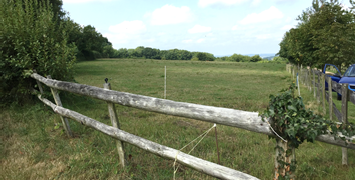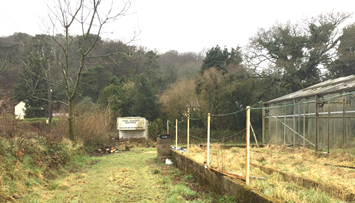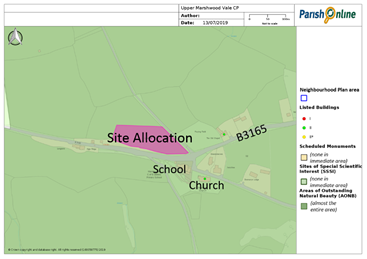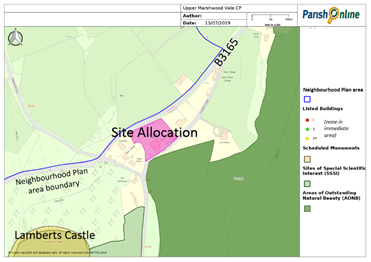
3.1 In response to the first consultation events, the feedback from local residents was that there would be some support for some housing growth, tourism and home working, and a clear desire to support a range of community facilities that can be sustained.
3.2 In terms of housing, the available evidence at the time of drafting this Plan suggested a very modest need for housing, primarily for more affordable house types (particularly 1-bedroom rental properties, starter homes and self-build plots) and live-work homes suited to people running a business from home. The adopted Local Plan (2015) does not specify how many homes may be needed in Upper Marshwood Vale, but gives an overall housing target for the whole West Dorset and Weymouth and Portland plan area, most of which is expected to be built in and around the main towns. The emerging Local Plan Review suggests a minimum target based on 2% growth over a 20 year plan period, which for our area would be about 7 houses. Eight affordable houses were recently built at Marshwood (Bramblehay), of which two 1-bed, four 2-bed and two 3-bed, and there also a small number of such houses in Stoke Abbott: all are occupied. Whilst there are no current plans to build another scheme of affordable homes like Bramblehay, the affordable housing needs will be looked at again when this Plan is reviewed.
3.3 It is even more difficult to pinpoint the likely need for new employment workspace. This very much depends on new enterprises by local residents, and the diversification or expansion of existing businesses. Whilst there is general support for enhancing community facilities, it is also important that these are viable, which often requires volunteer effort.
3.4 Similarly it is difficult to quantify any specific need for tourism. However the Local Plan is broadly supportive of low-key tourism appropriate to rural areas, provided that these do not damage the environment and those features that are so important to visitors. Such development should, where possible and practicable, be located within or close to established settlements, or make use of existing or replacement buildings. Farm diversification projects are also supported.
The following sustainability objectives helped guide the site-selection process:
Ecology - Protect and where possible enhance habitats and biodiversity
Landscape - Respect and reinforce the area’s rural landscapes and character
Heritage - Protect and where possible enhance the area’s heritage assets
Pollution - Avoid sites that may be affected by air / soil / water contamination
Flood Risk - Avoid development in flood risk areas
Soils and Minerals - Avoid using the highest quality agricultural land
Local Needs - Prioritise development that would meet local needs for affordable homes, jobs and community facilities
Safe Access - Ensure the sites are safe and accessible, and ideally on foot
3.5. As no sites had been identified as suitable for development within the Upper Marshwood Vale through the Local Plan (2015) process, the Neighbourhood Plan Group undertook their own ‘call for sites’ in January 2018. This gave landowners the opportunity to put forward their land for consideration. Four sites were submitted and a further 3 late submissions accepted. Six of these were in the west of the area around Marshwood. This included the site known as the Dungeon (to the north side of Marshwood), two sites close to Marshwood Primary School, two sites close to the Bottle Inn, and land at Three Counties Nurseries site further to the south. Another site on the edge of Shave Cross to the south of the Neighbourhood Plan area was also put forward. There were no sites suggested in Stoke Abbott or the other smaller settlements.
Colmer Stud site potentially for village shop and parking (also for school / church) and some housing

Three Counties Nurseries site for live-work units

3.6. The sites were checked against sustainable development objectives, and the community was consulted for their views on what development they would like to see where. With the recent closure of the Marshwood Shop, the potential for an alternative site for the village shop was a key consideration for local residents. With the two sites close to the school, the provision of an area for parking and improved play facilities was another concept that was supported by the local community.
3.7. However there was very little local support for housing on any of the sites, and only moderate support for holiday accommodation (which could potentially be pursued under the existing Local Plan policies). The landowners were contacted to discuss options that might better fit the community’s needs and aspirations. As a result, the following options were identified:
Colmer Stud site - potential for village shop / community hub, parking area (also for use by the church and school), with some limited housing:
the landowners of two sites close to the church and school offered land for a car-park (or other community facilities). A few houses could be built in order to provide sufficient financial return as well as meeting some of the identified local housing need. From the sustainability checks the Colmer Farm Stud site opposite the school is likely to be the better site for this development, including a new site for the village shop, although this does not rule out considering the land adjoining Gramarye Lodge in the future (perhaps for a children’s play area);
Three Counties Nurseries – potential for live-work units:
the former nursery has ceased trading as a horticultural business, and the site is falling into disrepair. The landowner has agreed that the site could be developed for live/work units.
3.8. The following pages deal with each of these sites in turn, including a brief description of the issues and a planning policy allocating each site for development and setting out the main planning matters to be considered. It will be down to the landowners to submit planning applications for each sites in due course, which will provide more detail. In all cases the deliverability and viability of the site allocations have been checked with the respective landowners who have confirmed that they would be able to deliver the policy requirements.
3.9. Other issues raised through this plan’s preparation included the potential benefits of relaxing the current requirements on re-use of existing buildings, in order to allow conversion to housing, Local enterprise would also benefit by making it easier for home working and small-scale business units to be permitted provided these remain small-scale and in locations unlikely to cause significant environmental harm. General policies have been included on these issues.
Did you know?
The Marshwood Community Land Trust (CLT) was created out of a project to build affordable housing (8 units) at Bramblehay in Marshwood. The CLT is a not for profit organisation owned and controlled by its local shareholders.
It could be a vehicle for other projects in years to come.
Bramblehay

Map showing the Colmer Stud Farm site

3.10. Marshwood stretches along the B3165 which is the busiest road in the Upper Marshwood Vale, connecting Crewkerne to Lyme Regis. The main built-up area lies just to the south of the Birdsmoorgate junction, with a short gap to a second smaller cluster of buildings around the parish church and school, and then sporadic development going south as far as the foot of Lambert’s Castle Hill. The slightly scattered nature of development does not help with the identity of the village, and thought has been given as part of the Neighbourhood Plan process whether development could help strengthen the village’s identity by linking some of the separate parts. However such an aim is long-term and limited by the small number of sites put forward by landowners through the call for sites.
3.11. Land at the entrance of Colmer Stud Farm is identified for a village shop and community hub (with facilities so that local people can meet here) with adjacent green space, a new car park to also serve the primary school and church (which have no parking at present), and up to four dwellings. The site assessment process flagged up the following key points:
3.12. Given the main reason for allocating the site is to provide the community benefits of a new shop and community hub plus off-road parking to also benefit the church and school, it will be necessary to ensure that the parking area, associated landscaping and the site for the shop / community hub is delivered as part of the scheme through suitable conditions or a legal agreement. The village shop / community hub will be separately funded, and should be proportionate to local need and not impact on the trading of nearby towns. The latest (2018) retail study for West Dorset shops under 300m² gross floorspace will not require a retail impact assessment. It is presently envisaged that the combined shop and community hub would occupy a gross floor space of between 150m² and 200m².
3.13. The housing, which is needed in order to incentivise the landowner to provide these community benefits, should be designed to meet local needs – primarily through ensuring these are not excessive in size and are used as a primary residence (not a second home or holiday let).
Meeting local needs - what we mean by primary residence
A primary residence is defined as one occupied as the residents’ sole or main residence, where the residents spend the majority of their time when not working away from home. A condition or obligation on new homes will require that they are occupied only as the primary residence of those persons entitled to occupy them.
Occupiers of homes with a primary residence condition or obligation will be advised to keep proof that they are satisfying the requirements of the policy. Proof of primary residence is via verifiable evidence which could include, for example (but not limited to) residents being registered on the local electoral register and being registered for and attending local services (such as healthcare, schools etc).
Policy UMV5. The Colmer Stud Farm site, Marshwood
The Colmer Stud Farm site, as shown on the Policies Map, is allocated for a village shop and community hub with adjacent green space, community parking (for use in association with the shop, community hub, school and church), and up to four dwellings, subject to all of the following criteria:
Map showing Three Counties Nurseries site

What are live-work units?
Live-work units are basically dwellings with workspace as an integral part (or otherwise clearly linked) to the properties.
For example they could be built as homes with workspace either on the ground floor (with accommodation above) or with a large workspace on the side, with the working area being more substantial in size than just a small home office.
Planning conditions can be used to make sure that the business floorspace of the live/work unit is finished ready for occupation before the residential floorspace is occupied, and that the dwelling cannot be occupied by a person unrelated to those employed, or last employed in the business occupying the business floorspace of that unit.
3.14. Land at Three Counties Nurseries is identified for up to five live-work units. The site assessment process flagged up the following key points:
Stoke Abbott |
Stoke Abbott |
Bettiscombe Village Hall |
Pilsdon Community |
Policy UMV6. The Three Counties Nurseries, Marshwood
The Three Counties Nurseries Site, as shown on the Policies Map, is allocated for up to five live-work units, subject to all of the following criteria:
3.15. The whole of Stoke Abbott village is designated as a Conservation Area. It is linear in form, very much tucked away in a narrow, winding valley and the abundant natural vegetation. There are a mix of cottages, farms, a pub, church and several gentry houses, and most buildings are positioned at the street edge or sit in larger plots.
3.16. There are no pavements in the village. Although the roads into and out of the village would not cope with a significant increase in traffic, some limited development may be possible if suitable sites were to come forward during the plan period. However in the absence of any sites being put forward for consideration in this Neighbourhood Plan, there are no site specific allocations.
3.17. The remaining area comprises scattered small settlements (hamlets) and winding country lanes within a farmed landscape. Further development in these smaller settlements is not likely to be sustainable due to the poor access and valued landscape. National planning policy is clear that development of isolated homes in the countryside should be avoided other than in exceptional circumstances, apart from the re-use of existing buildings and where there is a clear need for a farm-worker (or other rural-based occupation) to live on the site. However the Local Plan policies support agriculture, forestry and related enterprises including farm diversification, having particular regard to the need for the protection of the countryside and environmental constraints.
3.18. The re-use of existing buildings for housing, whether in Stoke Abbott, Marshwood or the wider rural area, can provide a useful source for local housing needs in an area where there are limited opportunities for new-building housing. Whilst nationally the Government made provision for the conversion of former agricultural buildings into housing through the use of permitted development rights, this did not extend to Areas of Outstanding Natural Beauty or to buildings that may have had an intervening use (such as holiday lets or workshops). Similarly whilst the adopted Local Plan relaxed its approach to the re-use of rural buildings for housing in 2015, it still required these to be in settlement of 200+ population or ‘tied’ through a legal agreement to a larger holding. As such the policy framework needs changing if we are to make the most of this as an option in the Upper Marshwood Vale. Given the emphasis on local needs and also the existing comparatively high levels of homes with no usual occupants (related to the prevalence of second homes and holidays) and therefore a restriction should be imposed to ensure these are used as a primary residence
|
|
|
|
3.19. The following policy uses some of the basic requirements for the conversion of existing buildings currently applied to buildings in or close to settlements of 200+ population, together with the general approach adopted nationally for agricultural conversions. As the local need for housing is for smaller and more affordable dwellings types, a size restriction is imposed (using the definition for smaller dwellings used in permitted development rights), to encourage buildings to be sub-divided into more than one dwelling where they would otherwise significantly exceed this size threshold. Parking requirements were raised as part of the consultation on this Plan and the parking standards used by Dorset Council would be applied. These require at least 1 parking space plus an additional visitor space for 1 and 2 bedroom conversions, and at least 2 parking spaces plus an additional visitor space for larger homes.
3.20. Given the landscape sensitivity to the area and the focus on affordable it is expected that the Local Planning Authority would be justified to consider imposing conditions that would limit further extensions and alternations through permitted development rights, however whether these rights are removed will depend on the merits of each case.
Policy UMV7. The residential conversion of existing buildings
The re-use of an existing lawful building to create one or more new dwellings will be permitted subject to all of the following criteria:
3.21. Without jobs for all sections of the community, we face a sterile existence with nothing for the go-getters amongst us to keep our lives fulfilled and valuable. We risk our area becoming a dormitory for many who have to travel to get and sustain jobs. Far better to develop local work for those that need employment or indeed employees for a sustainable future. Although this Neighbourhood Plan cannot conjure up new businesses, it can provide a supportive base from which opportunities could emerge with the right people, businesses and investment.
3.22. The Local Plan allows general employment uses (such as offices and workshops) within or on the edge of a settlement; through the intensification or extension of existing premises or the re-use or replacement of an existing building; or as part of a farm diversification scheme. It doesn’t specifically address opportunities for home working, which is a major part of this area’s employment base. The focus of the following policy has been included to provide a suitably flexible approach that supports home working and also new, small-scale workshop / office units (to allow home-based businesses and encourage local enterprise) in locations where significant adverse impacts should be avoided, bearing in mind the very rural nature of the area. A limit of 100m² per unit is suggested for the floor area – which reflects permitted development rights for new industrial buildings and warehouses on existing employment sites in sensitive areas. Larger-scale enterprises would be considered under the relevant Local Plan policies.
Employment opportunities
in the Upper Marshwood Vale
A – Agricultural changes:
Traditional farms can remain productive through diversification such as leisure, tourism and re-using redundant buildings.
B - Working from home:
Home-based businesses can provide occasional and full-time work. Superfast broadband access is often essential. Although starting up a business can be daunting, local mentoring and support can be a real help.
C – Small workshops / offices:
Small workshops or offices available on short leases at low cost rents can provide an important step to expand a home-based business or include an element of manufacturing or increased customer access.
D - Tourism, pubs, bed and breakfast, campsites and holiday lets:
From well-established operations to ad hoc and occasional lettings, tourism can produce a small but important boost to income.
E – Local retail
Although the local customer base is limited, with community support a local shop in Marshwood should be self-sustaining. Retail could also work as an element of other businesses (such as local crafts) although it is likely that most businesses will be more dependent on internet based sales.
Policy UMV8. Supporting small-scale employment enterprises
The use of existing lawful dwellings and associated outbuildings to facilitate home working will be supported provided the use would not give rise to an unacceptable level of disturbance to neighbours or have a significant adverse environmental impact.
The provision of new, small-scale workshop / office units (which could include some ancillary retail) to enable employment enterprises to set up or expand will be encouraged where:
Where new buildings for employment use are proposed, these should be subject to a condition or legal agreement ensuring it would remain available for business use.
< Previous | ^ Top | Next >